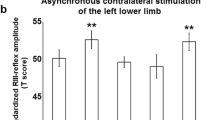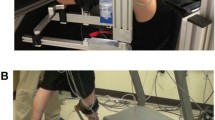Abstract
Animal experiments have shown that the nociceptive reflex can be used as an indicator of central temporal integration in the nociceptive system. The aim of the present study on humans was to investigate whether the nociceptive reflex, evoked by repetitive strong electrical sural nerve stimuli, increased when summation was reported by the volunteers. The reflexes were recorded from the biceps femoris and rectus femoris muscles in eight volunteers following a series of stimulations at 0.1, 1, 2, and 3 Hz. Each series consisted of five consecutive stimuli. Using 0.1- and 1-Hz stimulation, the reflex was not facilitated in the course of the five consecutive stimuli. Following 2- and 3-Hz stimulation, the reflex size (root mean square amplitude) increased significantly during the course of the fifth stimulus. This reflex facilitation was followed by a significant increase (summation) in the pain magnitude when compared with 1- and 0.1-Hz stimulation. Furthermore, the threshold for psychophysical summation could be determined. This threshold (stimulus intensity) decreased when the stimulus frequency (1–5 Hz) of the five consecutive stimuli was increased. The nociceptive reflex and the psychophysical summation threshold might be used to clarify and quantify aspects of temporal summation within the human nociceptive system.
Similar content being viewed by others
References
Adriaensen H, Gybels J, Handwerker HO, Van Hees J (1983) Response properties of thin myelinated (AS) fibres in human skin nerves. J Neurophysiol 49:111–122
Andersen O, Jensen LM, Brennum J, Arendt-Nielsen L (1993) C-fibre mediated facilitation of the human nociceptive reflex. 7th World Congress on Pain Abstract Book, IASP Publications, Seattle (14) p 7
Andreassen S, Arendt-Nielsen L (1987) Muscle fibre conduction velocity in motor units of the human anterior tibial muscle: a new size principle parameter. J Physiol 391:561–571
Arendt-Nielsen L, Bjerring P (1988) Sensory and pain threshold characteristics to laser stimuli. J Neurol Neurosurg Psychiatry 51:35–42
Arendt-Nielsen L, Øberg B, Bjerring P (1990) Quantitative assessment of extradural bupivacaine analgesia. Br J Anaesthesiol 65:633–638
Arner S, Meyerson BA (1988) Lack of analgesic effect of opioids on neuropathic and idiopathic forms of pain. Pain 33:397–400
Campbell IG, Carstens E, Watkins LR (1991) Comparison of human pain sensation and flexion withdrawal evoked by noxious radiant heat. Pain 45:259–268
Cooper BY, Vierck CJ, Yeomans DC (1986) Selective reduction of second pain sensation by systemic morphine in humans. Pain 24:93–116
Desmedt JE, Godaux E (1976) Habituation of exteroceptive suppression and of exteroceptive reflexes in man as influenced by voluntary contraction. Brain Res 106:21–29
Dimitrijevic MR, Nathan PW (1970) Studies of spasticity in man. 4. Changes in flexion reflex with repetitive cutaneous stimulation in spinal man. Brain 93:743–768
Dimitrijevic MR, Nathan PW (1971) Studies of spasticity in man. 5. Dishabituation of the flexion reflex in spinal man. Brain 94:77–90
Dowman R (1991) Spinal and supraspinal correlates of nociception in man. Pain 45:269–281
Dubner R (1991) Reply to Dickenson and Sullivan on ‘NMDA receptors and central hyperalgesic states’. Pain 46:346
Granat FR, Saelens JK (1973) Effect of stimulus intensity on the potency of some analgesic agents. Arch Int Pharmacodyn Ther 2054:52–60
Hagbarth KE (1960) Spinal withdrawal reflexes in the human lower limbs. J Neurol Neurosurg Psychiatry 23:222–227
Jurna I, Heinz G (1979) Differential effects of morphine and opioid analgesics on A and C fiber-evoked activity is ascending axons of the rat spinal cord. Brain Res 171:573–576
Kugelberg E (1948) Demonstration of A and C fibre components in the babinski plantar response and the pathological flexion reflex. Brain 71:304–319
Kugelberg E, Eklund K, Grimby L (1960) An electromyographic study of the nociceptive reflexes of the lower limb. Mechanism of the plantar responses. Brain 83:394–410
Le Bars D, Guilbaud G, Jurna I, Besson JM (1976) Differential effects of morphine on responses of dorsal horn lamina V type cells elicited by A and C fibre stimulation in the spinal cat. Brain Res 115:518–524
McGrath PA, Sharav Y, Dubner R, Gracely RH (1981) Masseter inhibitory periods and sensations evoked by electrical tooth pulp stimulation. Pain 10:1–17
Meinck H-M, Piesiur-Strehlow B, Koehler W (1981) Some principles of flexor reflex generation in human leg muscles. Electroencephalogr Clin Neurophysiol 52:140–150
Mendell LM (1966) Physiological properties of unmyelinated fibre projection to the spinal cord. Exp Neurol 16:316–332
Price DD (1972) Characteristics of second pain and flexion reflexes indicative of prolonged central summation. Exp Neurol 37:371–387
Price DD, Hu JW, Dubner R, Gracely RH (1977) Peripheral suppression of first pain and central summation of second pain evoked by noxious heat pulses. Pain 3:57–68
Price DD, Hayes RL, Ruda M, Dubner R (1978) Spatial and temporal transformations on input to spinothalamic tract neurons and their relation to somatic sensations. J Neurophysiol 41:933–947
Price DD, McHaffie JG, Larson MA (1989) Spatial summation of heat-induced pain: influence of stimulus area and spatial separation of stimuli on perceived pain sensation intensity and unpleasantness. J Neurophysiol 62:1270–1279
Schoenen J, Jamart B, Gerard P, Lenarduzzi P, Delwaide PJ (1987) Exteroceptive suppression of temporalis muscle activity in chronic headache. Neurology 37:1834–1836
Shahani BT, Young RR (1971) Human flexor reflexes. J Neurol Neurosurg Psychiatry 34:616–627
Van Hees J, Gybels J (1981) C Nociceptor activity in human nerve during painful and non painful skin stimulation. J Neurol Neurosurg Psychiatry 44:600–607
Von Frey M (1896) Untersuchungen über die menschliche Haut, des XXIII Bandes der Abhandlungen der mathematisch-physischen Classe der königlich Sächsischen Gesellschaft der Wissenschaften, no. III. bei S. Hirzel, Leipzig
Wagman IH, Price DD (1969) Responses of dorsal horn cells of M mulatta to cutaneous and sural nerve A and C fiber stimuli. J Neurophysiol 32:803–817
Willer JC, Brussel B (1980) Evidence for a direct spinal mechanism in morphine-induced inhibition of nociceptive reflexes in humans. Brain Res 187:212–215
Author information
Authors and Affiliations
Rights and permissions
About this article
Cite this article
Arendt-Nielsen, L., Brennum, J., Sindrup, S. et al. Electrophysiological and psychophysical quantification of temporal summation in the human nociceptive system. Europ. J. Appl. Physiol. 68, 266–273 (1994). https://doi.org/10.1007/BF00376776
Accepted:
Issue Date:
DOI: https://doi.org/10.1007/BF00376776




